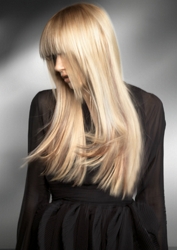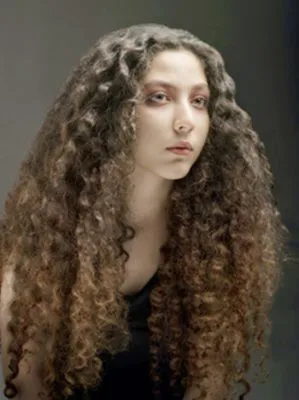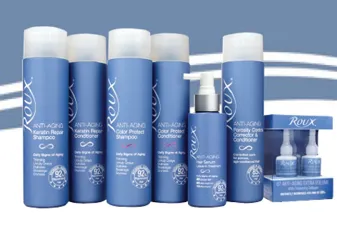
Do I Have Hair Porosity?
Dear Karen,
After a few terrible home hair color disasters my waist length hair was so damaged my hairstylist told me it needed to be cut. She recommended that I go with shoulder length hair which she promised would remove the damage. My hairstylist said that my hair was moisture deprived and suffering from major major loss due to all the recent bleaching and coloring.
I don't want to have so much of my hair cut off so I've been applying lots and lots of hydrating products including rinse out, leave-in and deep conditioners.
Unfortunately the more conditioners I apply the more my hair swells up. It always looks swollen and puffy. It also feels very rough. It also never seems to fully dry in some isolated sections.
Do I have hair porosity issues? Does this mean I have to get my hair cut like my stylist said?
Is there some way I can fix this without a major chop?
Thanks for any advice.
Laura
Answer
Dear Laura,
Bleaching, chemical treatments and damage from home hair color may result in cuticles which are so damaged that they can no longer properly retain moisture. The scales may actually become so damaged they are temporarily or permanently lifted.
Although hair which is overly porous feels dry, damaged and parched it can actually absorb excessive amounts of water. Moisture absorption and moisture loss are the primary concerns for porous hair.
While healthy hair can absorb approximately 30% of its weight in water during cleansing, porous hair may absorb up to 50% or more of its weight. In fact, the more porous and damaged your hair, the more water and moisture it will absorb.
Even though overly porous hair is absorbing lots of moisture, it's not able to retain it. It's like trying to fill up a bowl with water when there's a hole in the side. You may eventually be able to get the bowl full of water but ultimately it will drain right back out.
The more porous your hair, the more easily it absorbs water and the faster it loses it. Overly porous hair is more prone to breaking when soaking wet. It can also shrink as it dries. Ironically it may become spongy or hard to dry in some spots. When moisture is high in your environment your hair will also most likely frizz.
Do you need to get your hair cut to reverse the damage and the porosity challenges? Only you can ultimately make that decision. Can you restore your hair to a more healthy less porous state? It depends but if you're willing to try there are treatments which may help.
Apple Cider Vinegar Rinse
Many hair experts believe that a weekly rinse with acid based apple cider vinegar (ACV) will help by temporarily reducing porosity. The ACV will help by constricting the cuticle's scales. Combine 1/4th cup of apple cider vinegar with 2 cups of cool water in a clean plastic bowl.
Use the ACV mixture as a final rinse after cleansing and applying any rinse-out conditioner. Rinse hair completely and then gently squeeze out excess water with fingers. Pour the ACV over the hair catching the ACV liquid in the bowl. Continue to pour the ACV rinse through the hair until it was been completely absorbed into your cuticles. Rinse with cool water.
Another benefit of an ACV rinse is that it will also add shine to your hair, eliminate porosity related tangles, and increase overall manageability. If your hair does not respond well to the ACV rinse it may be that you need to increase the amount of water mixed with the apple cider vinegar. ACV rinses should leave your hair feeling soft.
Protein And Related Treatments
Hair professionals often treat damaged cuticles with special protein conditioners. Protein rich hair treatments are designed to fill in the rips, tears and gaps which occur when hair is over-processed.
The conditioning treatment not only fills in the gaps and holes but it binds to the hair actually mending the exterior scales along the length of the cuticle. Generally speaking the higher the porosity the higher the protein content which should be applied.
Protein conditioning treatments applied either at home or in the salon may reinforce the layers of the cuticles and help your hair to retain moisture better.
Protein Treatments Don't Work For All Hair Types
It's important to note that protein treatments do not work for all types of overly porous hair. In some cases although it can smooth, protein treatments can cause hair to become even more dry. One option is to seal hair after the protein treatment with a carrier oil, butter or similar emollient product.
In a worse case scenario protein treatment can leave hair greasy, oily and limp with dryness underneath. Some hair consumers believe that products with a high concentrations in propylene glycol can cause greasiness, oiliness and limpness.
Products with a high concentration of wheat proteins are often thought to be the best bet for strengthening the cuticle without leaving hair feeling crunchy. Some products known to be helpful including Kenra Moisturizing Conditioner, CHI Keratin Mist and Aphogee 2 Minute Keratin Reconstructor to name just a few.
Another popular option is to use proteins which wash off easily, like amino acids.
Other Tips
If your hair is suffering from damage and porosity it's important to rethink your cleansing routine. Follow the tips below:
1. Only wash hair as frequently as absolutely necessary.
2. Wash detangled hair in lukewarm water only. Hot water is known to dry out tresses.3. Alternate between a Diluted Shampoo (DS), Conditioner Only Wash (CoWash) or Water Only (WO) Wash. You may wish to use a clarifying product in-between the other wash cycles. Avoid shampoo products with sulfates or products which are known to be drying.
4. It may be helpful to apply a light jojoba oil to hair as a pre-wash treatment. Some people find that the pre-treatment helps hair to absorb moisture better.5. Always detangle hair in shower after apply a light rinse out conditioner. Since porous hair is especially fragile, detangle slowly and carefully in small horizontal sections using your fingers or a wide tooth comb.
6. Experiment with a warm water final rinse rather than a cool one. Warm water will keep the cuticle open which will make them more conducive to leave-in conditioners or styling products.7. Clay treatments mixed with a moisturizing conditioner may help to smooth and coat the hair shaft to help lower porosity. When doing a clay treatment finish with a cool rinse rather than warm rinse.
Remember than very porous wet hair will naturally absorb any type of products more easily. Although it may seem you may need more product, be careful not to overdo since this can cause hair to bloat.
Deep Conditioners
Unlike protein treatments deep conditioners usually benefit all levels of hair porosity. Leave-in conditioners labeled as moisturizing or designed to assist with detangling will soften, enrich, moisture and strengthen damaged tresses. Both deep and leave-in conditioners with a protein component will help minimize frizz.
Keep in mind that at some point hair is so damaged it's impossible to permanently repair the hair. Treatments can help on a temporary basis, but long term the damage may ultimately need to be permanently removed.
If you're unwilling to go with a major chop you might go slowly and have only a few inches trimmed off each time to help you transition from waist length to shoulder length.
Best wishes,
Karen Marie Shelton
AskKarenBy submitting your question, you grant full permission to HairBoutique.com to publish it. Due to the volume of mail we receive, Karen regrets that she cannot respond to every question personally.
To AskKaren a question, send an e-mail to: askkaren@hairboutique.com
Social Media Network Information
Please follow us on Twitter at: https://Twitter.com/HairBoutique. I look forward to meeting new people from all walks of Twitter and learning from their Tweets.





















